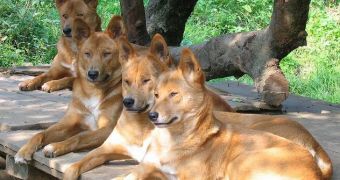In the old days, many thousands of years ago, the dingos were semi-domesticated human companions. Descended directly from wolves, these dogs lived around villages in Asia, being fed by the humans and sometimes assisting their masters in the hunting game. But, somewhere along the line, more than 4,000 years ago, they were set loose in Australia, and started reverting back to their former selves. They began to fear humans and travel in packs, while howling and generally exhibiting the same type of behavior as their ancestors.
This type of dog now occupies a large portion of Australia and the creature is considered one of the country's national animals, in addition to the kangaroo. Even though it did not have contact with humans for so many years, it still continues to recognize some of the hand gestures its former masters – our ancestors – used to control it and give directions with. The new work has been based on solidly documented knowledge, namely the fact that dogs, even as young as four months, tend to stare and investigate objects we point at. This happens with a wild wolf after several months of intensive training, even if it has been bred in captivity, LiveScience reports.
In a new scientific study published in the latest issue of the respected journal Animal Cognition, scientists from the University of South Australia in Magill detail their newest set of experiments on dingo domestication and gesture recognition. The work was conducted by student Bradley P. Smith and his graduate adviser, Carla A. Litchfield, who did their work on seven tamed but still untrained and undomesticated dingos in captivity. The conclusion of their research was that, somewhere along the line, dogs evolved so that they perceived more cues from us, which facilitated our two species' cohabitation.
In the experiments, the two scientists presented the seven dingos with two flowerpots, each of which had been meat-scented. One of them actually held a meat treat that the dogs were looking for. Then, a researcher stood behind one of the pots, tapped on it, or pointed at it. All dingos recognized the gestures automatically, and rushed to the respective flowerpots. Unlike dogs, however, the dingos were unable to read anything in their masters' eyes. When the researchers only looked at the pots after looking at the dogs, the animals did not pick up on any cues.

 14 DAY TRIAL //
14 DAY TRIAL //